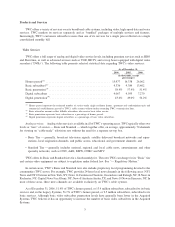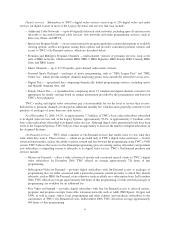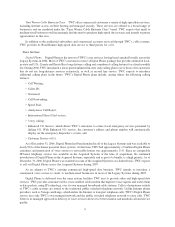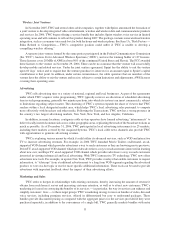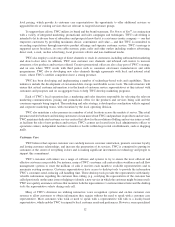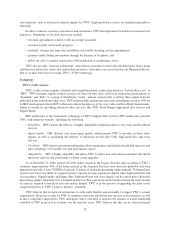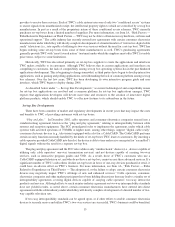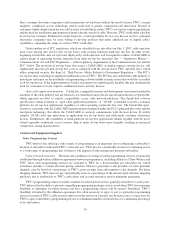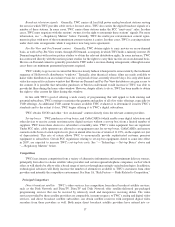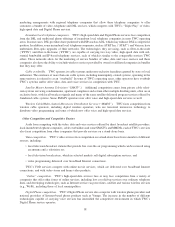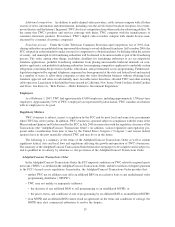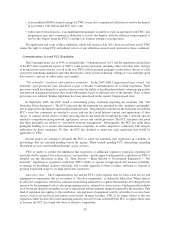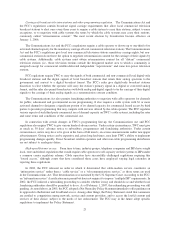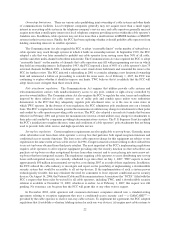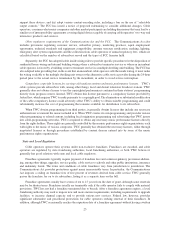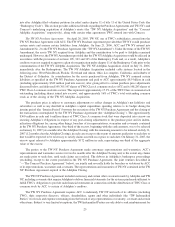Time Warner Cable 2006 Annual Report Download - page 20
Download and view the complete annual report
Please find page 20 of the 2006 Time Warner Cable annual report below. You can navigate through the pages in the report by either clicking on the pages listed below, or by using the keyword search tool below to find specific information within the annual report.provides to receive these services. Each of TWC’s cable systems uses one of only two “conditional access” systems
to secure signals from unauthorized receipt, the intellectual property rights to which are controlled by set-top box
manufacturers. In part as a result of the proprietary nature of these conditional access schemes, TWC currently
purchases set-top boxes from a limited number of suppliers. For more information, see Item 1A, “Risk Factors —
Risks Related to Dependence on Third Parties — TWC may not be able to obtain necessary hardware, software and
operational support.” The cable industry has recently entered into agreements with certain consumer electronics
manufacturers under which they will shortly complete development of a limited number of “interactive digital cable
ready” televisions (i.e., sets capable of utilizing its two-way services without the need for a set-top box). TWC has
begun ordering some set-top boxes from some of these manufacturers as well. TWC’s purchasing agreements
generally provide TWC with “most favored nation” treatment under which the suppliers must offer TWC favorable
price terms, subject to some limitations.
Historically, TWC has also relied primarily on set-top box suppliers to create the applications and interfaces
TWC makes available to its customers. Although TWC believes that its current applications and interfaces are
compelling to customers, the lack of compatibility among set-top box operating systems has in the past hindered
applications development. This is beginning to change somewhat, as third parties have begun to develop interactive
applications, such as gaming and polling applications, notwithstanding the lack of common platform among set-top
box schemes. Over the last few years, TWC has been developing its own interactive program guide and user
interface, which TWC began to deploy during 2006.
As described below under “— Set-top Box Developments,” as current technological and compatibility issues
for set-top box applications are resolved and a common platform for set-top box applications emerges, TWC
expects that applications developers will devote more time and resources to the creation of innovative digital
platform products, which should enable TWC to offer new features to its subscribers in the future.
Set-top Box Developments
There have been a number of market and regulatory developments in recent years that may impact the costs
and benefits to TWC of providing customers with set-top boxes.
“Plug and play.” In December 2002, cable operators and consumer-electronics companies entered into a
standard-setting agreement, known as the “plug and play agreement,” relating to interoperability between cable
systems and reception equipment. The FCC promulgated rules to implement the agreement, under which cable
systems with activated spectrum of 750MHz or higher must, among other things, support “digital cable ready”
consumer electronic devices (e.g., televisions) equipped with a slot for a CableCARD. The CableCARD performs
certain security functions normally handled by the kinds of set-top boxes TWC leases to customers. By inserting a
cable-operator provided CableCARD into this slot, the device is able to tune and receive encrypted (or “scrambled”)
digital signals without the need for a separate set-top box.
The plug and play agreement and the FCC rules address only “unidirectional” devices (i.e., devices capable of
utilizing only cable operators’ one-way transmission services) and not devices capable of carrying two-way
services, such as interactive program guides and VOD. As a result, those of TWC’s customers who use a
CableCARD equipped television set, and who do not have a set-top box, cannot access these advanced services. If a
significant number of TWC’s subscribers decline set-top boxes in favor of one-way devices purchased at retail, it
could have an adverse effect on TWC’s business. For more information, see Item 1A, “Risk Factors — Risks
Related to Dependence on Third Parties — The adoption of, or the failure to adopt, certain consumer electronics
devices may negatively impact TWC’s offerings of new and enhanced services.” Cable operators, consumer-
electronics companies and other market participants have been holding discussions that may lead to a similar set of
interoperability agreements covering digital devices capable of carrying cable operators’ two-way, interactive
products and services. Although efforts to reach an inter-industry agreement on two-way interoperability standards
have not yielded results, as noted above, certain consumer electronics manufacturers have entered into direct
agreements with the cable industry under which they will shortly complete development of a limited number of two-
way capable television sets.
If two-way interoperability standards can be agreed upon, or if other efforts to enable consumer electronics
devices to securely receive and utilize TWC’s two-way services are successful, TWC’s business could be benefited.
15


